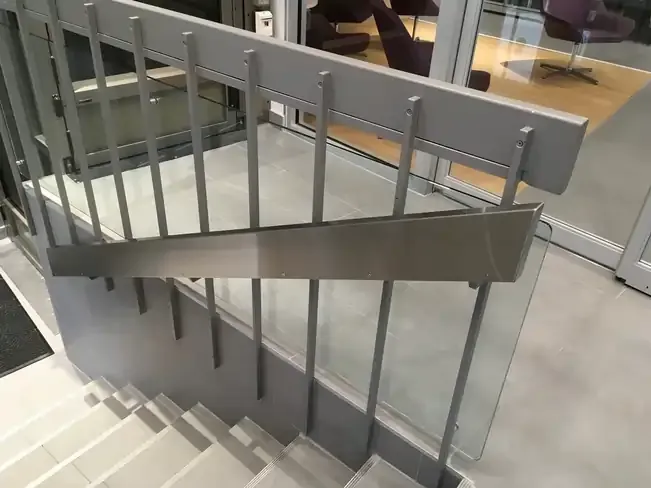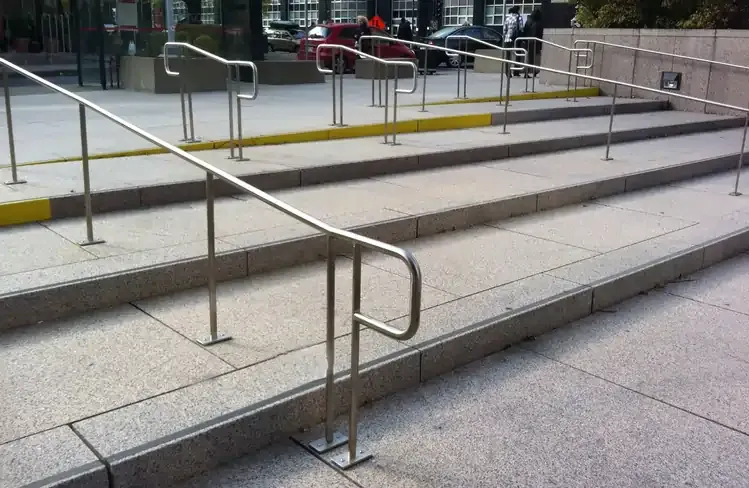Metal Railing For Stairs or Balconies: A Durable Design Element for Safety and Visual Appeal

Table of Contents
- Introduction
- Why Choose Metal Railings?
- Design Versatility and Customization
- Safety Benefits of Metal Railings
- Indoor vs. Outdoor Applications
- Installation Tips and Considerations
- Sourcing Metal Railings
- Conclusion
- FAQ
The balancing act between safety and style
When it comes to your home’s stairs or balconies, there’s no room for compromise. You want something that protects your loved ones and your investment without sacrificing on visual appeal. This is where metal railings shine.
Why metal railings are the gold standard
Tough, timeless, and undeniably stylish, metal railings have earned their reputation as a top-tier choice for residential and commercial properties alike. Whether you're renovating an indoor staircase or building a new outdoor balcony, metal offers the kind of performance and beauty that few other materials can match.
What this guide covers
In this comprehensive guide, we’ll walk you through everything you need to know about metal railings for stairs or balconies from their superior durability and low-maintenance advantages to their design flexibility and safety compliance. Whether you're drawn to their sleek modernity or their traditional charm, this guide will help you decide if metal railings are the right fit for your project.
Why Choose Metal Railings?
A. Unmatched Durability
If you’re looking for railings that will stand the test of time, metal is your best bet. Materials like steel and wrought iron are engineered to handle everything from heavy foot traffic to harsh weather conditions. Unlike wood, which can warp, crack, or rot over time, or glass, which is prone to breaking, metal stays strong and reliable for years, even decades, with minimal signs of wear.
In this comprehensive guide, we’ll walk you through everything you need to know about metal railings for stairs or balconies from their superior durability and low-maintenance advantages to their design flexibility and safety compliance. Whether you're drawn to their sleek modernity or their traditional charm, this guide will help you decide if metal railings are the right fit for your project.
B. Low Maintenance
Forget the endless cycle of staining, sealing, and sanding. Powder-coated or galvanized metal railings offer long-lasting protection against rust, corrosion, and fading. These finishes create a barrier that keeps moisture and UV damage at bay, making them ideal for outdoor applications.
In this comprehensive guide, we’ll walk you through everything you need to know about metal railings for stairs or balconies from their superior durability and low-maintenance advantages to their design flexibility and safety compliance. Whether you're drawn to their sleek modernity or their traditional charm, this guide will help you decide if metal railings are the right fit for your project.
C. Fire and Pest Resistance
While wood railings leave your home vulnerable to fire and insect infestations, metal naturally resists both. Steel and iron won’t catch fire, and they’re impervious to termites, carpenter ants, and other pests that can quietly eat away at your investment.
This built-in resilience makes metal not just a practical option but a protective one.
Design Versatility and Customization

A. Styles for Every Aesthetic
Metal railings are chameleons of design: equally at home in a chic downtown loft or a stately heritage home.
Craving clean lines and simplicity? Modern minimalist designs with smooth finishes and geometric shapes bring understated sophistication. Prefer something more timeless? Ornate, traditional patterns (think scrollwork and decorative finials) channel Old World elegance and grandeur.
Better still, metal railings offer seamless visual coherence between indoor and outdoor spaces. You can carry the same sleek steel look from your staircase to your balcony, maintaining a unified aesthetic across your entire property. That’s style synergy with structural integrity.
B. Tailor-Made Solutions
Not all homes, or tastes are created equal, and that’s where custom fabrication comes in. Whether you're working with a unique layout or a bold design vision, metal railings can be crafted to fit the exact dimensions and details of your space.
For those who want speed without sacrificing quality, many manufacturers also offer pre-assembled kits and adjustable fittings. These make installation smoother while still allowing for personalization. Perfect for DIYers or professionals on a deadline.
Safety Benefits of Metal Railings
A. Enhanced Structural Support
Metal railings don’t just look strong, they are strong. Engineered to endure heavy loads and sudden impact, they offer reliable support where it matters most. This is especially important in households with children racing up the stairs, pets darting around, or elderly family members who rely on handrails for balance.
Thanks to their rigid construction and secure fastening, metal railings are the go-to choice for safety-conscious homeowners, offering long-term peace of mind without compromising on design.
B. Regulatory Compliance in Canada
In Canada, building codes are governed provincially, but most align with the National Building Code of Canada (NBC), which sets clear guidelines to ensure safety in both residential and commercial structures.
Residential Standards (NBC – Part 9: Housing and Small Buildings)
- Guardrails are required for any walking surface over 600 mm (approximately 24 inches) above ground.
- They must be a minimum of 1070 mm (42 inches) high for exterior decks and 900 mm (36 inches) for interior stairs or landings.
- The space between spindles or balusters must be small enough to prevent a 100 mm (4 inch) sphere from passing through—critical for child safety.
- Handrails are mandatory on stairs with more than three risers, and must be between 865 mm and 965 mm (34–38 inches) high.
- Handrail ends must be finished in a way that avoids snagging (e.g., returned to a wall or post).
Commercial/Workplace Safety (Canadian Occupational Health and Safety Regulations)
For workplaces or multi-unit dwellings, stricter standards may apply:
- Guardrails must typically be at least 1070 mm (42 inches) in height.
- Railings must resist a concentrated load of 0.9 kN (about 200 lbs) applied in any direction along the top rail.
- Where open sides exist on platforms or mezzanines, intermediate rails or panels must be installed if the vertical opening exceeds 450 mm (about 18 inches).
Indoor vs. Outdoor Applications
A. Weather Resistance
Metal railings are built to endure the elements. Whether you’re dealing with intense UV exposure, heavy rainfall, or snowy Canadian winters, finishes like powder coating and galvanization offer robust protection against rust, corrosion, and surface wear.
This makes metal railings an ideal choice for outdoor installations such as balconies, porches, and decks. Anywhere that needs safety without sacrificing style. Unlike wood, which can warp or rot, or plastic, which can fade and crack, metal stands the test of time through every season.
B. Consistent Visual Appeal
Why choose one look for your stairs and a different one for your balcony? Metal railings allow you to extend the same aesthetic indoors and outdoors, creating a cohesive visual narrative throughout your home.
Want a brushed steel finish that runs from your staircase to your backyard patio? Or a matte black wrought iron look that ties your interior banister to your upper-level balcony? With metal, design unity is easy to achieve, whether you’re upgrading one space or the entire property.
Installation Essentials
A. Installation Basics
Installing metal railings is all about precision and preparation. You’ll need:
- Mounting brackets suited for your surface material (concrete, wood, tile, etc.)
- Durable fasteners to ensure long-lasting support
- Leveling tools for perfect alignment and balance
Above all, accurate measurement is non-negotiable. From post spacing to rail height, exact dimensions ensure both safety and compliance with building codes. Missteps here can mean uneven rails or failed inspections, two things no one wants.
Professional vs. DIY
If you’re handy and working with a pre-assembled kit, DIY installation is totally doable. Many suppliers, like Regal or Metal City Fab, offer step-by-step guides and adjustable systems that simplify the process.
However, for custom-fabricated railings, multi-level projects, or installations involving concrete or irregular surfaces, hiring a professional is often the safer bet. Pros bring the tools, experience, and code knowledge to get the job done right and fast.
No matter the route you choose, supplier support is key. Look for companies that offer tech assistance, templates, and compatibility tools to make the process smooth from start to finish.
Sourcing Metal Railings
A. Notable Suppliers & Resources
When it comes to finding quality metal railings, partnering with a trusted supplier makes all the difference. Here are a few standout options:
- United Stainless
With over 35 years of expertise, United Stainless is one of Canada’s leading specialists in stainless steel and other metals. They offer:- 1: Custom CAD design and drafting, ensuring precise fit and aesthetic harmony
- 2: Full fabrication services: laser/plasma cutting, folding, welding, rolling, and polishing
- 3: Certified welders and compliance with CWB CSA W47.1, supported by rigorous RBQ‑approved quality control
- 4: Proven performance in industrial, architectural, and even pharmaceutical settings, trusted by brands like Molson and Pratt & Whitney
- Bezdan Railings
A leading name in Canadian railing systems, Bezdan offers a wide selection of components, finishes, and styles tailored for both residential and commercial projects. Their catalog features everything from sleek stainless steel to ornamental iron. - Metal City Fab
Known for custom solutions, Metal City Fab specializes in made-to-measure metalwork with an eye for design. Their expertise lies in turning complex ideas into precisely fabricated railing systems. - Regal Railing
Ideal for DIYers, Regal’s products are widely available at major retailers and come with pre-assembled components and easy-to-follow installation manuals. Their systems are engineered for straightforward setup and code compliance.
Installation Manuals & Buying Guides
Whether you’re planning a hands-on installation or working with a contractor, guides like the Regal Railing Installation Guide and NAAMM Stair Manual provide invaluable insights into proper setup, safety standards, and design tips. These resources help ensure your railing project is both beautiful and code-compliant.
Final Thoughts
Summary of Benefits: Safety, Style, Longevity
Metal railings strike the perfect balance between aesthetic appeal and functional performance. With their robust structural support, low maintenance, and design versatility, they bring a sense of permanence and elegance to any space, indoors or out.
Whether you're enhancing a staircase or securing a balcony, metal railings deliver peace of mind while elevating your home’s architectural charm.
Reassurance for Homeowners: A Futureproof Investment
Choosing metal is more than a stylistic decision, it’s a smart investment. Resistant to wear, weather, pests, and time, these railings are built to last for decades. Homeowners can trust they’re making a futureproof choice that enhances safety today and retains value for years to come.
FAQs
What is the best metal for exterior railings?
Stainless steel and galvanized steel are top choices for exterior railings due to their superior resistance to rust, corrosion, and UV exposure. Wrought iron is also popular for its durability and classic look, especially with a protective coating.
Are metal railings more expensive than wood?
While the upfront cost of metal can be higher, the long-term value is significant. Metal requires less maintenance, is more durable, and won’t need frequent replacement or treatment like wood, making it more cost-effective over time.
Can I install metal railings myself?
Yes, many systems, such as those from Regal Railing, are designed for DIY installation with pre-assembled components and guides. For complex or custom installations, hiring a professional ensures safety and code compliance.
How do I maintain metal railings over time?
Maintenance is minimal. Simply clean periodically with mild soap and water, and inspect for scratches or chips in the coating. For exterior installations, applying a protective wax or sealant annually can help extend longevity.
Do metal railings rust?
Not if they’re properly coated. Powder-coated, galvanized, or stainless steel railings are highly resistant to rust. With proper care and occasional touch-ups, they’ll maintain their finish and structural integrity for decades.